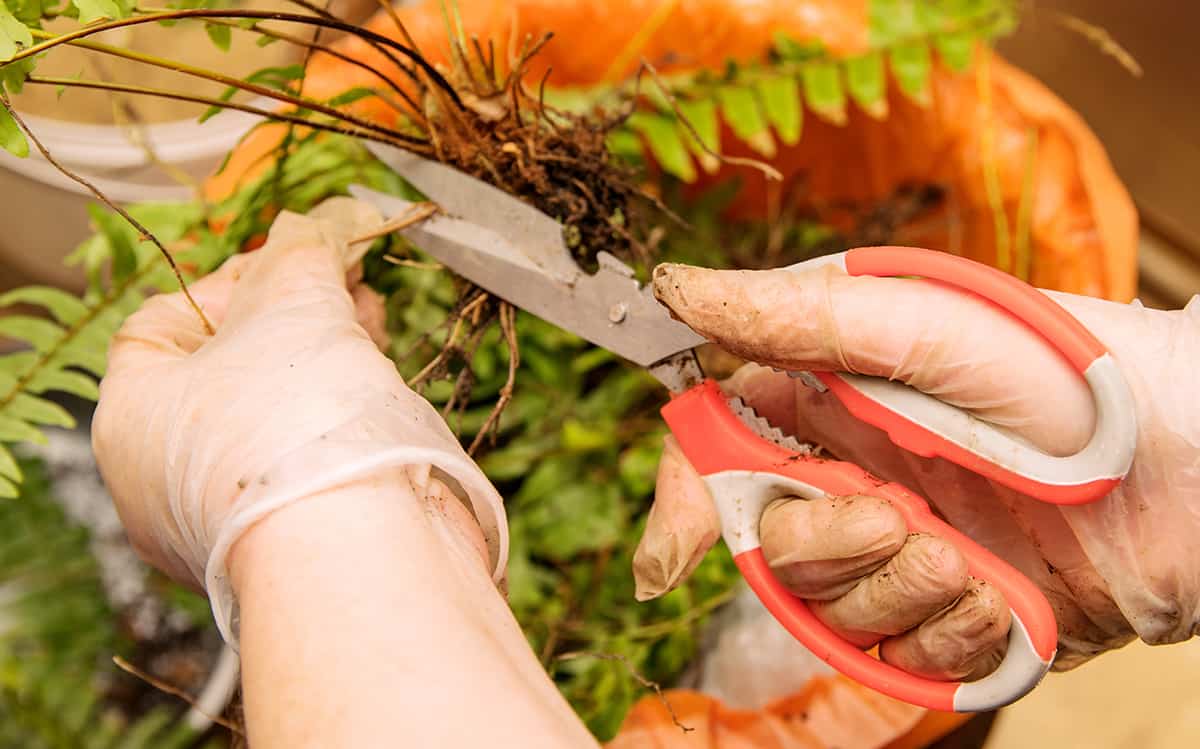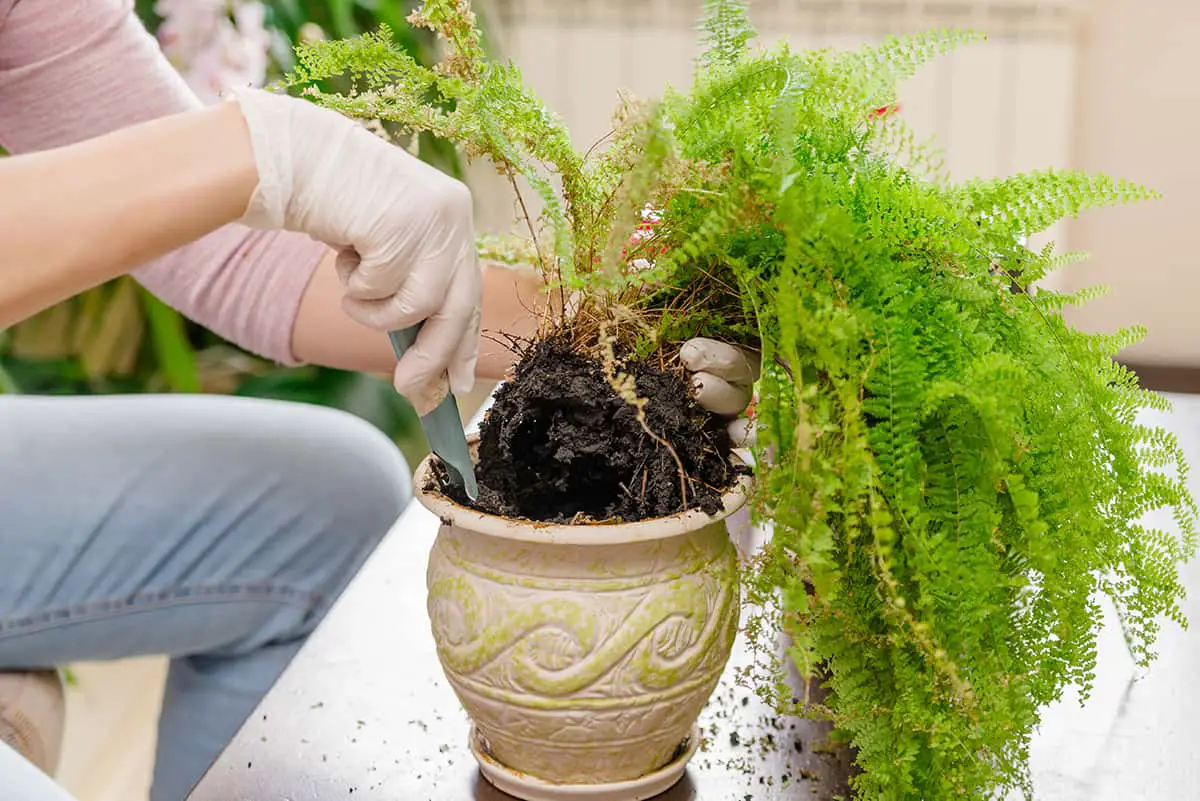Ferns are perennial plants that can be evergreen or deciduous, depending on the variety you have. If you need to transplant a potted fern to a larger container or move a fern from one site on your property to another, then it’s important to understand how to transplant ferns successfully and when is the best time to transplant ferns. Trying to dig up and move a fern at the wrong time can result in significant damage to the plant and even cause it to die.
Here, we reveal the key tips you need to know for transplanting any fern.
Table of Contents
Can You Transplant Ferns?
You may want to transplant your fern for any number of reasons, and this is perfectly safe to do as long as you follow a few simple guidelines. Ferns growing in containers may reach a point where they become rootbound and need to be transplanted into a larger container where they can spread their roots, and this is true for indoor and outdoor ferns in pots.
For ferns planted in the ground, you may want to transplant them to a more suitable location, or you may feel like rearranging the plants in your borders for a new and fresh look. Many types of ferns will spread via their rhizomatous roots, and when they become large enough you can dig them up and divide them to make multiple plants and then re-plant them in various locations.
Whatever your reason for transplanting ferns, the key points to remember are that most ferns will fare best when transplanted during their dormant phase, and the transplanted ferns may need extra care while they become settled in their new spots.
How to Transplant Outdoor Ferns

Ferns that are growing outside in the ground soil should be transplanted in late winter or early spring, when the plant is still in its dormant phase. Whether your fern is evergreen or deciduous, it will enter a period of dormancy over winter where it does not produce new foliage or grow its roots and instead focuses on retaining energy for the upcoming period of vigorous growth in the spring and summer.
By transplanting during this time, minimal harm will be done to the plant, and it will be able to settle into its new home before entering a new phase of growth.
- Before starting to dig up your fern for transplanting, prepare the site where you want to move your fern to so that it’s ready to go. This will typically include digging a suitable-sized hole in the soil and laying some well-rotted compost in the base of the hole.
- Use a trowel to dig a wide circle in the soil around your fern. A good guide is to dig a few inches further than the drip line of the plant in order to keep as much of the root system intact as possible. Use a spade or shovel to dig beneath the fern and lift the whole plant, including the roots, out from the ground.
- Use your hands to gently rub the roots together to dislodge any old soil, and remove as much of the soil as you can without causing damage to the roots. If you plan to divide the fern to make several plants, you should do this now by separating the root ball into portions using a sharp knife or shovel.
- Transport your fern to its new site, carrying it by the roots rather than the foliage, as this is prone to breaking. Set the roots down in your previously dug hole so that the soil will sit at the same level on the plant as before. Fill around the roots with fresh soil and compost, then press down on the soil to ensure it provides adequate support to the plant.
- Add plenty of water to the transplanted fern, and routinely add more water to prevent the soil from drying out, especially while the ferns are getting established in their new positions.
- Mulch over the soil to help retain moisture and keep the roots of the fern cool.
How to Transplant Indoor Ferns
Indoor ferns can be transplanted or repotted at any time, but early spring will give your plants the best chances of thriving in their new pots. By transplanting in early spring, you won’t interrupt the ferns’ period of rapid growth, but once it enters the growing phase, it will quickly spread out into its new home.
- Transplant a potted indoor fern by first preparing a clean pot one or two sizes bigger than the ferns current container. Avoid using a pot drastically bigger because this can overwhelm the roots of the plant with too much nutrients and moisture. Add a layer of fresh soil or compost to the bottom of the new pot.
- Remove the fern from its current pot by squeezing it and pulling the plant up from the base of the foliage, taking care not to pull too hard and snap the fronds.
- Once the fern is out of the old pot, gently remove old soil and separate the root ball slightly by rubbing the roots between your thumb and forefinger.
- Now, you can set the fern into its new pot and fill in the space around the root ball with more fresh soil and compost. Press down on the soil to make sure the plant is held firmly in place.
- Water the plant generously and move it back to its usual spot. Continue care as normal.
Best Time to Transplant Ferns

The best time to transplant ferns is during their dormant phase throughout winter and early spring. For the best chance of success, transplant toward the end of winter or the beginning of spring when the plant is almost ready to enter its growth phase. This will help it to settle into its new home quickly.
Transplanting ferns on cloudy days or in the early evening can also help to limit the chance of the plant suffering from transplant shock since there will be minimal demands on the plant during low light.
Tips for Transplanting Ferns
Water generously
Most ferns thrive in moist soils or wet and boggy conditions, but after they have been transplanted, they will have an even higher need for moisture. It’s important not to let the soil of a fern dry out in the months following a transplant, and instead ensure there is always moisture in the soil to help the plant become established in its new surroundings.
Trim foliage
If your fern is quite large, then after transplanting it can help to trim down the foliage. This will help the plant focus its energy on sending out strong roots into its new soil rather than delivering energy to maintain the foliage.
Choose your time
Ferns are quite hardy plants that respond well to transplanting, but choosing the best time to transplant your fern can mean the difference between a healthy, thriving plant and a weak, struggling plant. Always transplant ferns during their dormant phase in winter or early spring to help them remain strong and ensure their survival.






